If you walk along Foothill Blvd to the field station, you may be enjoying the masses of Common Fiddleneck (Amsinckia intermedia) and Distant Phacelia (Phacelia distans) blooming in the parkway, spurred on by the unusually rainy winter. Both Common Fiddleneck and Distant Phacelia are characteristic annuals of California Sage Scrub – a native plant community that once dominated most of our area but is now quite rare. It is, however, still preserved at the BFS, and the flowers that have spread into the parkway give passersby a chance to enjoy our our very own mini-“Super Bloom”
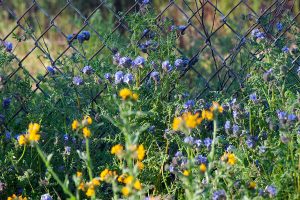
Distant Phacelia (Phacelia distans) and Common Fiddleneck (Amsinckia intermedia) in front of the Foothill Blvd fence. ©Nancy Hamlett.
But human passersby are not the only ones enjoying this floral abundance. Both Common Fiddleneck and Distant Phacelia are favorites of many local insects, such as the Painted Lady butterflies, which delighted many Claremonters during their massive migration through our area.
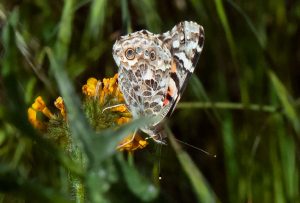
A Painted Lady butterfly (Vanessa cardui) nectaring on Common Fiddleneck (Amsinckia intermedia) in the Foothill Blvd parkway. ©Nancy Hamlett.
Having plants that support native insects are more important than ever, as they can help to combat the “Insect Apocalypse”.
Have you heard about the “Insect Apocalypse”? In 2017, German researchers reported that flying insect populations in 63 protected nature areas had declined by more than 75% between 1989 and 2016. Although this astonishing number brought widespread attention to insect decline and lead to the term “Insect Apocalypse”, declines in many specific insect groups, including European butterflies, honeybees, and British moths, have have been reported for years. But the German group’s study was unique in that it covered all flying insects instead of specific populations.
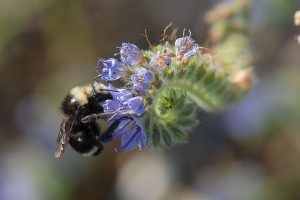
A Yellow-Faced Bumble Bee (Bombus vosnesenskii) nectaring on Common Fiddleneck (Amsinckia intermedia) in the Foothill Blvd parkway. ©Nancy Hamlett.
Why are insects in decline? A new review article concludes habitat loss is the main driver of the declines, with agrochemical pollutants, invasive species, and climate change as additional causes.
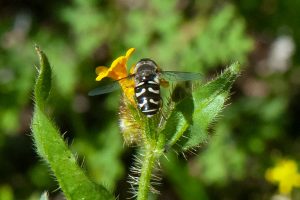
A Bird Hover Fly (Eupeodes volucris) nectaring on Common Fiddleneck (Amsinckia intermedia) in the Foothill Blvd parkway. Hover Flies, also known as Flower Flies, are important pollinators, and their larvae eat aphids, thrips, and other plant-sucking insects. ©Nancy Hamlett.
Why should you care? Ecosystem depend on insects. Insects are food for many birds, fish, reptiles, and amphibians and are also essential for pollination of many plants. Insects are also crucial to soil health, nutrient recycling, and ecosystem functioning. Francisco Sánchez-Bayo, from the University of Sydney, Australia, and coauthor of the recent review, told the Guardian, “If insect-species losses cannot be halted, this will have catastrophic consequences for both the planet’s ecosystems and for the survival of mankind.”

A sawfly (Filacus sp.) on Distant Phacelia (Phacelia distans) in the Foothill Blvd parkway. Sawflies are related to bees and wasps, but don’t sting. Filacus larvae specifically eat Phacelia and Amsinckia. ©Nancy Hamlett.
What can you do? In your own home, you can reduce the use of pesticides, plant native plants that are used by insects, and buy organic produce. You can also support policies and legislation that conserve or restore native habitats and promote more insect-friendly agricultural practices, such as discouraging the use of pesticides.
Here are some more insects recently spotted in the parkway, including more butterflies…
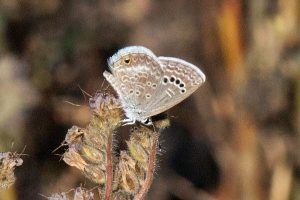
A Reakirt’s Blue butterfly (Echinargus isola) on Distant Phacelia (Phacelia distans) in the Foothill Blvd parkway. Reakirt’s Blues are uncommon in our area.©Nancy Hamlett.

Funereal Duskywing (Erynnis funeralis) nectaring on Distant Phacelia (Phacelia distans). ©Nancy Hamlett.
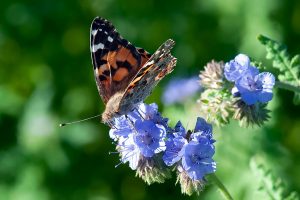
Another Painted Lady (Vanessa cardui) – this one is nectaring on Distant Phacelia (Phacelia distans). ©Nancy Hamlett.
…more bumblebees,…

A Black-tailed Bumble Bee (Bombus melanopygus) nectaring on Common Fiddleneck (Amsinckia intermedia) in the Foothill Blvd parkway. ©Nancy Hamlett.
…more hoverflies,…
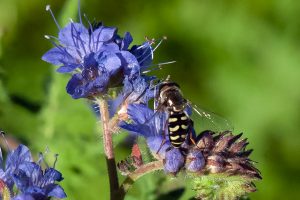
Another Bird Hover Fly (Eupeodes volucris) – this one is on Distant Phacelia (Phacelia distans) in the Foothill Blvd parkway. ©Nancy Hamlett.
…and snakeflies, too!
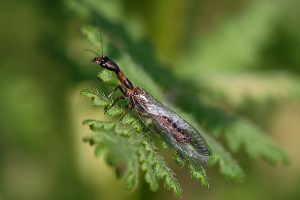
A snakefly (Agulla sp.) resting on Distant Phacelia (Phacelia distans)in the Foothill Blvd parkway. Snakeflies are important predators on aphids and mites and have been considered for biological pest control in agriculture. ©Nancy Hamlett.
Please look and enjoy as you stroll along the boulevard!
References:
- Hallmann CA, Sorg M, Jongejans E, Siepel H, Hofland N, Schwan H, et al. (2017) More than 75 percent decline over 27 years in total flying insect biomass in protected areas. PLoS ONE 12(10): e0185809. https://doi.org/10.1371/journal.pone.0185809
- Sánchez-Bayoa F and Wyckhuys KAG (2019) Worldwide decline of the entomofauna: A review of its drivers. Biological Conservation 232: 8-27. https://www.sciencedirect.com/science/article/pii/S0006320718313636?via%3Dihub
- Suzuki D (2019) “You may not like insects, but you need them,” Straight.com (website for The Georgia Straight)https://www.straight.com/news/1202901/david-suzuki-you-may-not-insects-you-need-them
- Damian Carrington D (2019) Plummeting insect numbers ‘threaten collapse of nature.’ The Guardian Sun 10 Feb 2019 https://www.theguardian.com/environment/2019/feb/10/plummeting-insect-numbers-threaten-collapse-of-nature